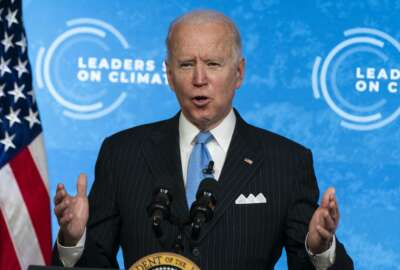Biden administration doubles down on greener energy for agencies, USPS electric vehicles
The Biden administration is in the market for greener sources of electricity for the federal government, a significant step in a decades-long plan set into motion...
The Biden administration is in the market for greener sources of electricity for the federal government, a significant step in a decades-long plan set into motion by a recent executive order.
The Defense Department and the General Services Administration released a request for information Thursday, asking energy suppliers how they expect to deliver on the administration’s goal of the federal government running 100% on carbon pollution-free electricity by 2030.
The Biden administration, meanwhile, is pressuring the Postal Service, an agency with one of the largest vehicle fleets in government, to make electric vehicles a greater part of its multibillion-dollar next-generation vehicle fleet contract.
These and other actions from the Biden administration underscore a full-court press to make its goal of achieving net-zero greenhouse gas emissions across all federal operations by 2050 a reality.
However, agencies supportive of the administration’s agenda recognize there are significant challenges in meeting all of the green-governments goals in President Biden’s executive order signed in December.
DoD and GSA, under the RFI, are asking vendors for feedback on the feasibility of meeting the executive order’s targets, as well as identifying potential barriers or performance risks in reaching this goal.
GSA Administrator Robin Carnahan said moving agencies completely to carbon pollution-free electricity will create more clean-energy jobs, and “put the country on the path toward a more resilient and sustainable future.”
“As a leader in procuring electricity for government, GSA is committed to working with DoD and other partner agencies to move us all toward sourcing 100% carbon pollution-free electricity,” Carnahan said.
The RFI states that the administration is interested in signing contracts lasting up to 10 years, with the goal of phasing carbon pollution-free electricity into its FY 2022 competitive retail procurements, and with contract deliveries that would begin in 2023.
The federal government, according to the RFI, may combine the green electricity procurement of several agencies, “to achieve economies of scale, where appropriate.”
The RFI also asks current suppliers of energy to the federal government to outline how they plan to transition to carbon pollution-free electricity.
GSA and DoD will accept responses to the RFI through March 7.
Preferred energy sources outlined in the RFI include marine energy, solar, wind, geothermal, hydroelectric, nuclear and hydrokinetic.
“There is a preference for [carbon pollution-free electricity] supply to be from new or previously underutilized generation sources,” the RFI states.
GSA and DoD, as part of the RFI, are also requesting Renewable Energy Certificates (RECs) or other accounting mechanisms from vendors to guarantee the electricity supplied is coming from a sustainable source.
The RFI states the federal government will also accept energy from fossil fuels, so long as “there is active capture and storage of carbon dioxide emissions that meet EPA requirements.”
The agencies expect the executive order to result in U.S. energy companies supplying 10 gigawatts of new clean energy by 2030.
The federal government, between GSA and the Defense Logistics Agency, purchase more than 9 terawatt-hours of electricity every year.
DoD sees opportunities and limits to mitigating climate change
Deputy Defense Secretary Kathleen Hicks said the RFI shows the energy sector that DoD is “well underway” with efforts to meet the executive order’s goals.
DoD is the largest consumer of energy in the federal government, its largest emitter of greenhouse gases and one of the biggest buyers of electricity in the world.
“It’s not just critical to addressing the threat of climate change, but also to our national security as we work to secure U.S. competitiveness in rapidly-shifting global energy markets,” Hicks said.
Richard Kidd, the deputy assistant secretary of defense for energy & environment resilience, said DoD views climate change as a threat to readiness, and sees a need to reduce its greenhouse gases footprint to reduce the impact on its operations,
Kidd said DoD alone has a greenhouse gas footprint on par with Portugal, and is about the 55th largest emitter of greenhouse gases in the world.
“The federal government and the country do not get where it needs to be without contributions from the department,” Kidd said Wednesday during a meeting of the Defense Business Board.
DoD is working to not just mitigate the severity of climate change’s impact on its future readiness, but also to reduce the harm it’s already having on agency operations.
A longer and more intense season of wildfires means National Guard brigades are spending more time fighting wildfires and less time on combat training, Kidd said. He also said climate change is also expected to speed up the degradation of DoD’s aircraft, vehicles and installations.
Meanwhile, near-peer competitors like China are currently investing in plans to transition to clean-energy energy, but Kidd warns the United States isn’t “keeping pace.”
“This is not an either-or proposition, the department either prepares to fight or the department takes steps to adapt to climate change. If we do not adapt to climate change, it will adversely affect our readiness and our mission effectiveness,” Kidd said.
DoD issued a request for information this summer, asking its major suppliers about their targets to reduce greenhouse gas emissions, as well as the environmental impact of their supply chains.
Kidd said, at least anecdotally, companies who supply to DoD, but also do business internationally, particularly in Europe, “have a more robust and clearer understanding of their greenhouse gas emissions.”
While the Biden administration has linked its clean-energy goals up with its “Buy American” goals, Kidd said U.S. vendors are comparatively less familiar with the emissions embedded in their supply chains.
“Companies whose only business is in America, or primary business is America, and their primary customer is the Department of Defense, have a much less robust posture on climate change [and] greenhouse gas emissions,” Kidd said.
While DoD is taking steps where it can, Kidd said there are limits to where the agency can realistically reduce its carbon footprint.
“Realistically, the department is always going to have greenhouse gas emissions,” Kidd said, adding that DoD will most likely have to look at carbon capture and sequestration technologies at some point to minimize its impact.
More than two-thirds of DoD’s greenhouse gas emissions come from its operational force.
“It’s really a lot harder to think of a zero-emission F-35 counterpart, or zero-emission Marine taskforce or a zero-emission armored brigade combat team, so there’s a lot of challenges there,” Kidd said.
White House presses USPS on ‘critical opportunity to buy electric vehicles
The Biden administration, meanwhile, is warning it may hold up the Postal Service’s plans to acquire its next-generation fleet, over concerns that the agency is not making electric vehicles a top priority.
The White House Council on Environmental Quality and the Environmental Protection Agency, in separate letters to USPS, criticized the agency’s plans for most of its next-generation delivery vehicles to run on fossil fuels.
Both agencies also told USPS that the current environmental analysis of its contract award to Oshkosh Defense doesn’t give a complete picture of the environmental impact, and urged USPS to conduct a more thorough analysis.
EPA Associate Administrator Vicki Arroyo told USPS that its current plan to make electric vehicles 10% of its new fleet, at minimum, is “plainly inconsistent” with the administration’s goals.
“The Postal Service’s proposal as currently crafted represents a crucial lost opportunity to more rapidly reduce the carbon footprint of one of the largest government fleets in the world,” Arroyo wrote.
The Postal Service’s vehicle fleet is second only to DoD, and accounts for nearly half of federal civilian vehicles.
CEQ Chairwoman Brenda Mallory, in her letter to Postmaster General Louis DeJoy, said the agency’s contract marks a “critical opportunity” for electric vehicles to make up 70% of its total fleet.
“This available pathway would put USPS in a position to achieve dramatically positive effects for public health, climate crisis, and American competitiveness,” Mallory wrote.
Mallory said the White House is urging USPS to update its environmental review of its next-generation delivery vehicle contract, arguing that the current version does not give a full accounting of the expected environmental impact.
CEQ urged USPS to improve its next-generation vehicle fleet and make a decision that “that is grounded on sound legal footing.”
“If it does not do so, Congress or the federal courts may compel USPS to alter course,” Mallory said.
Arroyo said new USPS vehicles that run on gasoline would not “make meaningful progress” in reducing USPS greenhouse gases, and would only achieve 8.6 miles per gallon of gas. That’s only a slight improvement from the 8.2 miles per gallon average of its current fleet.
The EPA is also calling on USPS to accept public comments and hold public hearings about its next-generation vehicle contract.
Mallory said the administration “strongly backs” the $6 billion USPS would receive under the Build Back Better Act, which it would use to purchase more electric vehicles and charging stations.
That legislation, however, doesn’t have the support it needs in the Senate, and is unlikely to pass in its current form.
Mallory said the White House also supports USPS using its existing resources, “including its significant cash reserves,” to invest in more electric vehicles
USPS ended 2021 with more than $23 billion in cash.
“Through these approaches and others, we are confident that USPS has the tools it needs to act now,” Mallory wrote.
The Washington Post first reported on the CEQ and EPA’s letters to USPS on Wednesday.
Copyright © 2025 Federal News Network. All rights reserved. This website is not intended for users located within the European Economic Area.
Jory Heckman is a reporter at Federal News Network covering U.S. Postal Service, IRS, big data and technology issues.
Follow @jheckmanWFED





